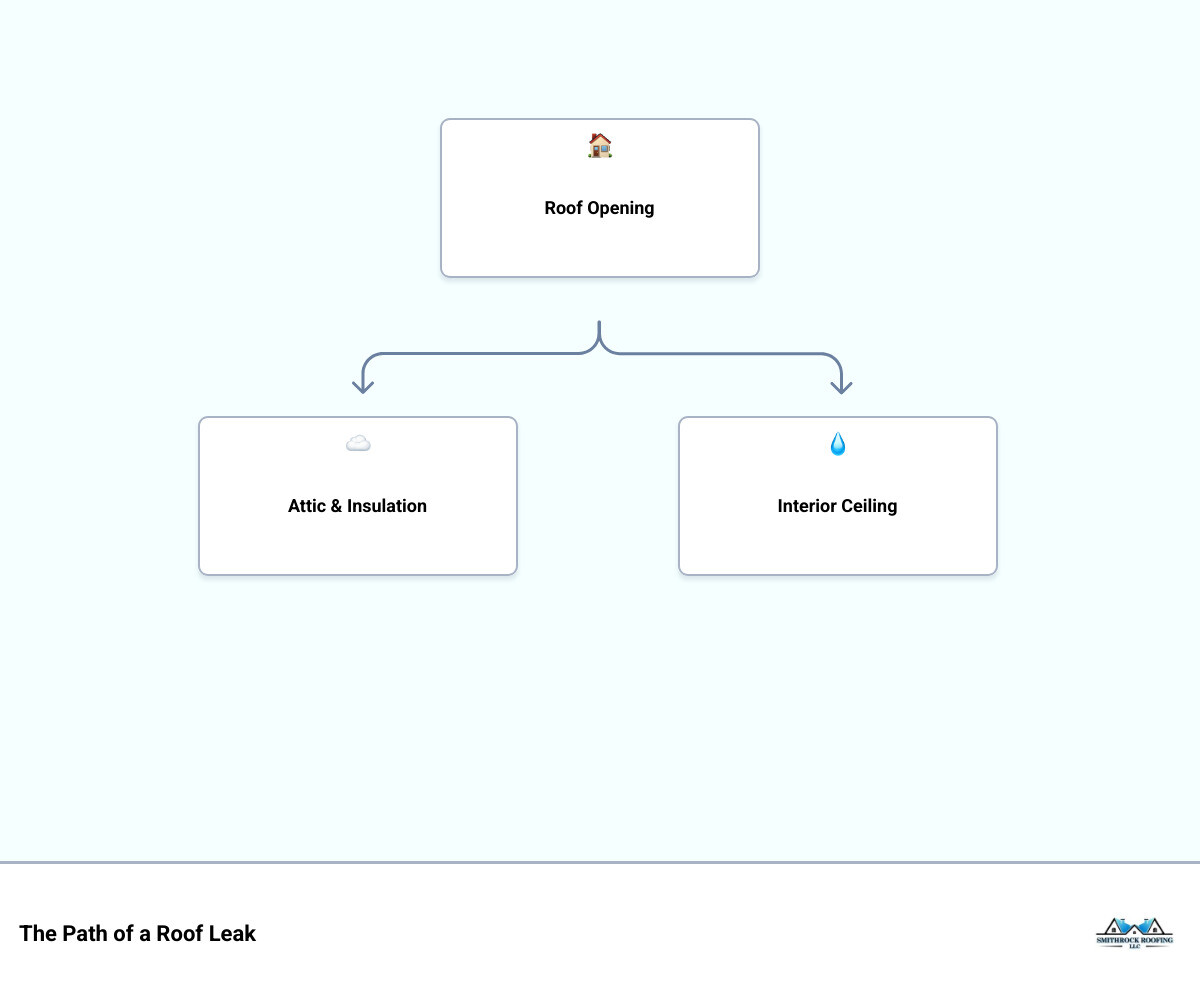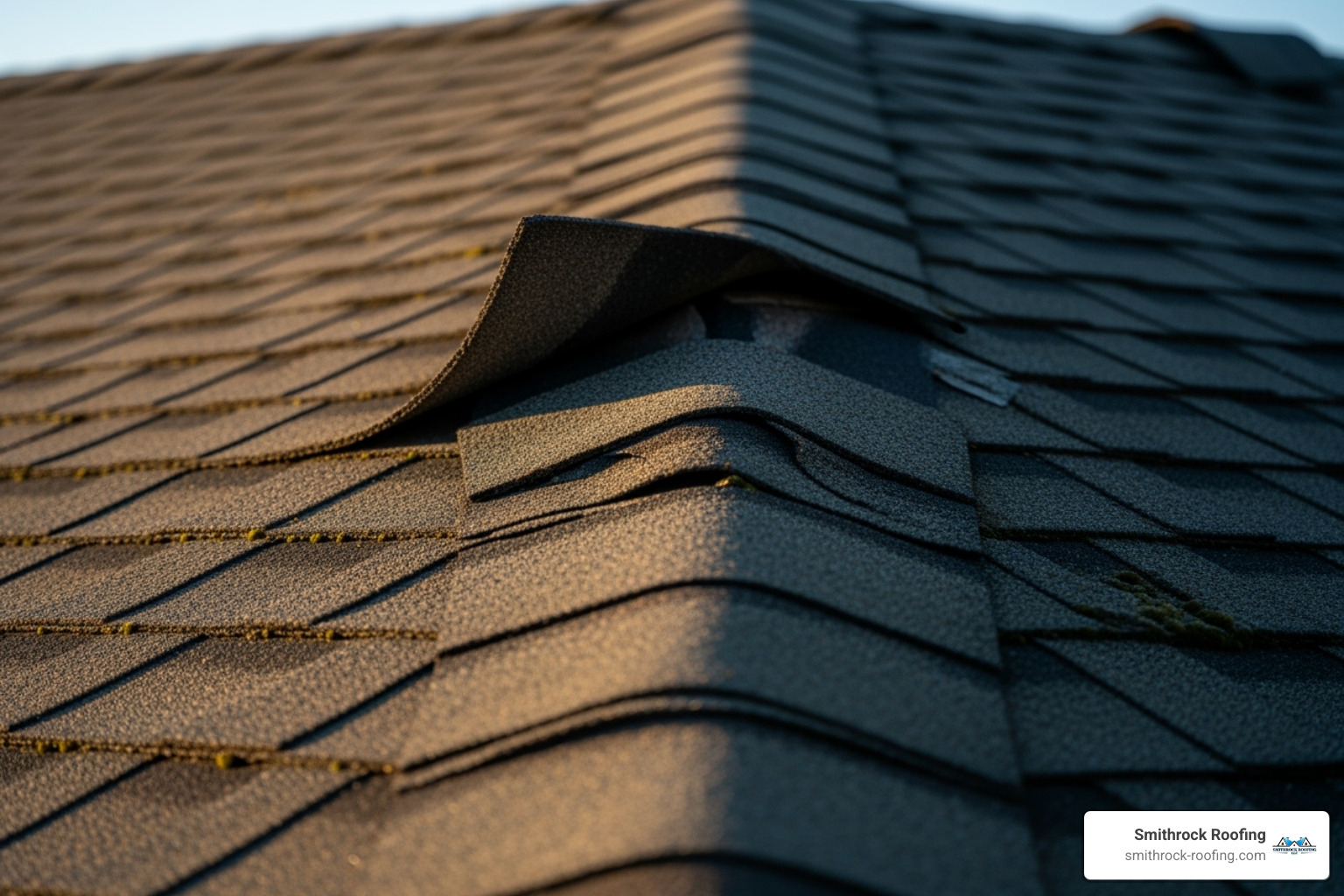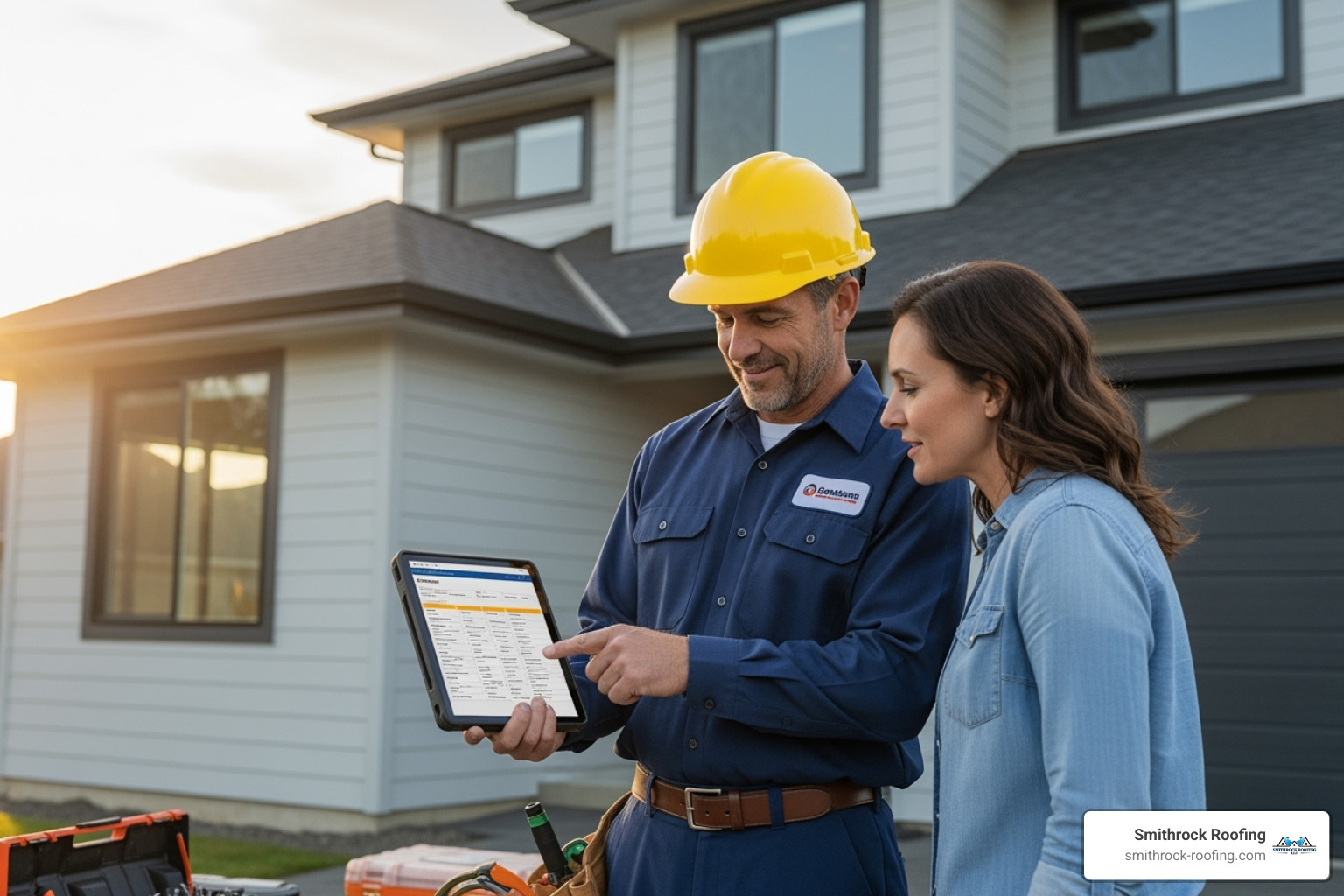Coming home to find water dripping from your ceiling or a new, ominous stain spreading across a wall is a homeowner’s nightmare. This is more than just an inconvenience; it’s a critical alert that your home’s primary defense against the elements has been breached. Prompt and effective roof leak repair is essential to protect your home from a cascade of serious issues, including pervasive water damage, hazardous mold growth, and expensive structural failures.
Quick Action Steps for a Leaking Roof:
The problem isn’t just the water you see. Water is deceptive; it can enter through a tiny crack in a shingle, travel sideways along rafters and roof decking, and soak insulation before finally appearing as a stain on your ceiling, often far from the original entry point. By the time you notice a leak, water has likely been infiltrating your roof structure for some time, silently causing damage.
Every hour you wait, the damage compounds. Water begins to rot wooden framing and roof decking, turning solid structures spongy and weak. It saturates insulation, rendering it useless and dramatically increasing your energy bills. Most dangerously, it creates a damp, dark environment perfect for mold and mildew, which can cause serious respiratory problems and allergic reactions. What starts as a minor repair can quickly escalate into thousands of dollars in remediation for structure, insulation, and mold if left unchecked. This guide walks you through everything you need to know about roof leak repair. You’ll learn how to identify where your roof is leaking, understand the cause, take immediate action, and decide when to call in professional help. We’ll cover common causes—from damaged shingles to clogged gutters—so you can protect your home and make informed decisions.

Effective roof leak repair starts with a bit of detective work. Finding the precise point of water entry is often the trickiest part of the process, as water can travel a considerable distance from where it gets in to where it finally shows up. A systematic approach, however, can help you track down even the most elusive leaks.
The first signs of a roof leak almost always appear inside your house. Be vigilant for these indicators:
Once you spot these signs, grab a powerful flashlight and head to the attic. Be careful where you step, only putting weight on the wooden joists or designated flooring to avoid falling through the ceiling. Look for water marks or dark streaks on the underside of your roof decking (the plywood or OSB sheathing). Check for damp, compressed, or discolored spots in your insulation. Also, look for “shiners”—nails that missed the framing joists during construction. In cold weather, warm, moist attic air can condense and freeze on these cold nails. When the temperature rises, the frost melts and drips, perfectly mimicking a roof leak.
For more detailed guidance on what to look for, visit our page on Roof Inspection.
Sometimes the source is obvious from the outside, but safety must be your absolute top priority. Only attempt an exterior inspection on a clear, calm, and dry day. Never get on a roof when it’s raining, windy, wet, or icy.
Wear sturdy, rubber-soled shoes for maximum grip. Ensure your ladder is placed on firm, level ground and extends at least three feet above the roofline. It’s always best to have a spotter on the ground. If your roof is high, has a steep pitch, or if you are at all uncomfortable with heights, do not risk it. Call a professional.
Once safely on the roof, methodically check for these common culprits:
If a visual inspection doesn’t reveal the source, a controlled water test is the next step. This method is invaluable for finding leaks where water travels a long distance from its entry point.
You’ll need a helper inside the house, armed with a cell phone and a flashlight, positioned near where the leak appears. From the outside, use a garden hose to soak the roof in isolated sections. Start low, just above the area where the leak is visible indoors, and work your way uphill. Do not use a high-pressure nozzle, as this can force water into places it wouldn’t normally go and can damage shingles. Apply a steady, gentle stream of water to one section for several minutes at a time. Patience is crucial, as it can take a while for the water to travel through the roof system. When your helper inside shouts that they see a drip, you’ve successfully isolated the leak’s location and are ready to proceed with roof leak repair.
Understanding why roofs leak is half the battle in effective roof leak repair. Your roof is a complex system of interconnected components, and when one part fails, the entire system becomes vulnerable. Most leaks can be traced back to a few common culprits: material aging, weather-related damage, or flaws in installation.

Asphalt shingles, the most common roofing material, typically have a lifespan of 25-30 years. As they age, they lose their flexibility and weather resistance. Look for these warning signs:
Flashing refers to the pieces of metal (usually aluminum or galvanized steel) installed at any joint, intersection, or penetration on your roof. Its job is to create a watertight barrier that directs water away from vulnerable areas like chimneys, vents, skylights, and wall intersections. Flashing is a leading cause of roof leaks because it can fail due to rust, corrosion, or deteriorated sealant. Over time, the caulk or roofing cement used to seal flashing can dry out, shrink, and crack. Improper installation—using the wrong type of flashing or failing to integrate it correctly with the shingles—can create problems from day one. The fascia and soffit at your roof’s edge are also critical; learn more on our Fascia and Soffit Repair page.
North Carolina weather can be particularly tough on roofs. High winds can get underneath shingle edges, breaking their adhesive seal and lifting or tearing them off. Hail damage is often subtle but destructive; hailstones can create “bruises” on shingles, fracturing the underlying fiberglass mat without being obvious from the ground. This hidden damage compromises the shingle’s integrity and leads to future leaks. Debris from fallen branches can physically puncture your roof, while even smaller twigs and leaves can accumulate in valleys and create dams that trap water. In winter, ice dams are a major threat. They form when heat escaping from your attic melts snow on the roof. The water runs down to the colder eaves, where it refreezes. This process repeats, building a dam of ice that causes water to pool behind it, back up under the shingles, and leak into your home.
We specialize in repairing storm damage. Learn more on our Wind Damage Repair and Hail Damage Roofers pages.
Not all leak sources are related to direct roof damage. Poor attic ventilation traps warm, moist air that rises from your living space. This moisture condenses on the cold underside of your roof decking, much like a glass of ice water on a humid day. Over time, this constant condensation can lead to wood rot, mold growth, and leaks that appear to come from the inside out. Clogged gutters are another major, often overlooked, culprit. When gutters and downspouts are blocked with leaves and debris, rainwater has nowhere to go. It overflows, soaking the fascia boards and potentially backing up under the edge of your roof, seeping beneath the shingles and into your home’s structure. Regular cleaning and proper Gutter Installation are essential for preventing these issues.
When you discover a roof leak, your immediate actions can mean the difference between a minor inconvenience and a major disaster. It’s crucial to understand the distinction between a temporary stopgap and a permanent solution. Temporary roof leak repair is an emergency measure designed solely to protect your home’s interior until a professional, permanent fix can be made.
Your first priority is damage control inside the house. Follow these steps immediately:
Once the interior is protected, you might consider a temporary exterior fix, but only if conditions are absolutely safe. Never go on a roof during a storm or if it is wet, icy, or windy. These fixes are best for small, easily accessible leaks and are not a substitute for professional repair.
These are all short-term solutions. For more ideas, this breakdown of roof leak fixes offers helpful insights.
Temporary fixes are designed to fail. Roofing cement will crack under UV exposure, patches will peel, and tarps will eventually tear or be dislodged by wind. More importantly, they only mask the symptom without addressing the root cause of the leak. A professional roof leak repair involves a thorough diagnosis to determine why the leak happened—be it aging shingles, failed flashing, damaged underlayment, or a structural issue.
Professionals have the training and tools for proper material matching and sealing, ensuring a durable, watertight repair that integrates seamlessly with your existing roof. They can identify and repair hidden structural damage to your roof decking or rafters that a DIY patch would miss. Most importantly, reputable contractors provide workmanship warranties, giving you peace of mind that the job is done right and that you’re covered if the fix doesn’t hold. Our Roof Repair Services are designed to provide lasting solutions, not just a temporary patch.
| Aspect | Temporary DIY Fixes | Professional Permanent Repair |
|---|---|---|
| Cost | Low initial material cost | Higher initial cost, but prevents future expenses |
| Durability | Short-term, susceptible to weather, temporary | Long-lasting, designed to withstand elements |
| Skill Level | Basic DIY skills, some risk involved | Expert knowledge, specialized tools, safety protocols |
| Long-Term Effectiveness | Does not address root cause, prone to re-leaking | Addresses root cause, ensures watertight seal, extends roof life |
| Warranty | None | Often includes workmanship and material warranties |
| Safety | High risk for untrained individuals | Minimized risk due to training, equipment, and insurance |
| Structural Integrity | Does not assess or repair hidden structural damage | Includes assessment and repair of hidden structural damage |
| Peace of Mind | Short-lived, constant worry about recurrence | Long-term assurance, knowing the problem is truly solved |

While the DIY spirit is commendable, roof leak repair is one area where knowing your limits is crucial for your safety and your home’s long-term health. An improper repair can not only fail to stop the leak but can also cause additional damage, void your roof’s warranty, and lead to a much costlier fix down the road.

Some situations are clear indicators that you need to put down the caulk gun and pick up the phone. Call a professional roofer immediately if you’re facing any of the following:
An improper repair can void your roof’s warranty and lead to more significant problems. Sometimes, the bigger question is whether to repair or replace. For help with this decision, see our guide on Roof Repair vs. Replacement in Winston Salem: What Homeowners Need to Know.
When you call a professional for roof leak repair, you’re investing in a systematic process that addresses the root cause. Here’s what you should expect:
Choosing the right contractor is the most important step. Beware of “storm chasers” who knock on doors after a storm, often performing shoddy work and disappearing. Look for these qualities in a roofer:
The best roof leak repair is the one you never have to make. While we are always here to help in a crisis, a proactive maintenance strategy is by far the most effective and affordable way to protect your home and avoid the stress and expense of emergency repairs.
Think of your roof like your car; it requires regular checkups to perform reliably and reach its maximum lifespan. Catching a single cracked shingle, a nail that has backed out, or a small section of failing sealant early can prevent a major leak that would otherwise damage your insulation, framing, and interior finishes. A minor fix that costs a few hundred dollars today can easily save you from a catastrophic failure costing thousands of dollars down the road.
Regular professional inspections are the cornerstone of good roof maintenance. We recommend a professional inspection at least once a year—ideally in the fall before winter or spring after the harshest weather has passed—and after any severe storm. These checkups allow a trained eye to identify subtle signs of wear and tear or potential problems that are not visible from the ground. Learn more about how they protect your investment by reading about the Benefits of Regular Roof Inspections.
Between professional visits, you can perform simple maintenance tasks to keep your roof in top shape:
By investing a little time in a seasonal maintenance routine, you can help your roof last its full expected lifespan and avoid the stress and expense of a premature failure. We’re here to help with professional inspections and maintenance, so we can catch problems before they become a crisis.
When facing a leaking roof, homeowners understandably have many urgent questions and concerns. Here are the answers to the ones we hear most often, providing clarity when you need it most.
Ignoring a “small” leak is one of the most costly mistakes a homeowner can make. It allows a minor problem to silently grow into an expensive disaster. The consequences include:
The timeline for a repair depends entirely on the cause and complexity of the job. Minor repairs, such as replacing a few missing shingles or sealing a cracked vent boot, can often be completed by a professional in one to three hours. More complex repairs, such as re-flashing a chimney, repairing a leaking valley, or replacing a section of damaged roof decking, might take a full day or more. Factors that influence the timeline include the extent of the underlying damage, weather conditions (repairs require dry weather), and the accessibility of your roof.
This is a critical question with a nuanced answer. Generally, homeowner’s insurance policies cover damage that is “sudden and accidental.” This means if your roof is damaged by a specific event like a storm, hail, or a fallen tree, your policy will likely cover the cost of the roof repair and the resulting interior water damage. However, if the leak is due to a lack of maintenance, wear and tear, or an old roof that has reached the end of its lifespan, the insurance company will likely deny the claim for the roof repair itself, though they may still cover the interior damage.
The cost can vary dramatically. A very minor repair might cost $150 – $400. A more moderate repair, like replacing flashing around a vent or a small section of shingles, could be in the $400 – $1,000 range. Major repairs, such as re-flashing a chimney or fixing a large area of damaged decking, can cost $1,000 – $3,000 or more. The final cost depends on the roof material, the pitch/accessibility of the roof, the extent of underlying damage, and local labor rates.
This is a crucial decision. While we always prefer to repair when it’s a viable option, sometimes a full replacement is the more responsible and cost-effective long-term solution. Key factors in this decision include:
A professional assessment is the best way to make an informed decision. We will provide an honest recommendation based on your roof’s condition and your long-term goals. Our New Roof Cost page can provide additional guidance.
Spotting a water stain on your ceiling or hearing the steady drip of a leak is a uniquely stressful moment for any homeowner. It’s a clear signal that the vital shield protecting your home, your family, and your belongings has been compromised. The good news is that with the right knowledge and swift, decisive action, you can minimize the damage, address the problem effectively, and restore your peace of mind.
Throughout this guide, the most critical lesson in roof leak repair is that time is not on your side. A seemingly small leak can cause significant and expensive hidden damage to your home’s structure and create unhealthy living conditions. While temporary fixes like tarps and roofing cement can serve as crucial first aid to prevent immediate interior damage, they are never a permanent solution. A lasting, reliable repair requires professional expertise to accurately diagnose the root cause, properly match materials, and execute a fix that ensures a durable, watertight seal for years to come.
The value of a professional roofer goes beyond the repair itself; it’s the confidence that comes from a thorough inspection, expert workmanship, and a solid warranty that stands behind the work. However, the best strategy is always prevention. Proactive maintenance, including annual professional inspections and routine tasks like keeping gutters clean, is the single most powerful tool you have to prevent leaks, extend your roof’s life, and save thousands of dollars in avoidable repairs. To learn more, explore the Benefits of Regular Roof Inspections.
Your roof is the silent guardian of your family and your largest financial investment. When it needs help, it deserves the best possible care. Whether you have an active leak that needs immediate attention or you want to be proactive about preventing future problems, Smithrock Roofing is here to help. We have built our reputation in the Winston Salem community on a foundation of quality, honesty, and treating every home as if it were our own.
Don’t wait for a small problem to escalate into a full-blown crisis. Contact us for a comprehensive inspection and estimate and let us show you what expert roof leak repair looks like. We’ll restore your roof and your peace of mind, keeping you safe and dry no matter what the weather brings.

Smithrock Roofing © Copyright 2025 • All Rights Reserved • Privacy Policy • Maintained by Mongoose Digital Marketing